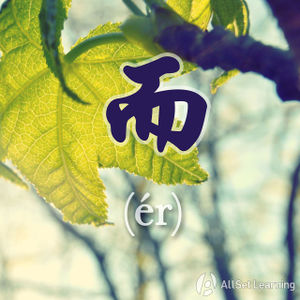Difference between revisions of "Using "er" to explain contrasting ideas"
| Line 26: | Line 26: | ||
* [[Integrated Chinese: Level 2, Part 1]] (pp. 343-4) [http://www.amazon.com/gp/product/0887276792/ref%3das_li_ss_tl?ie=UTF8&tag=allset-20&linkCode=as2&camp=217145&creative=399369&creativeASIN=0887276792 →buy] | * [[Integrated Chinese: Level 2, Part 1]] (pp. 343-4) [http://www.amazon.com/gp/product/0887276792/ref%3das_li_ss_tl?ie=UTF8&tag=allset-20&linkCode=as2&camp=217145&creative=399369&creativeASIN=0887276792 →buy] | ||
| + | |||
| + | ===Websites=== | ||
| + | |||
| + | * Yale Chinese Usage Dictionary: [[http://comet.cls.yale.edu/chineseusagedictionary/0235.html/ Usage of 而]] | ||
Revision as of 06:01, 17 June 2013
| This article is a stub. Editors can help the Chinese Grammar Wiki by expanding it. |
-
Level
-
Similar to
-
Used for
-
Keywords
The conjunction 而 (ér) is used to connect two sentences that are related to each other, but talk about contrasting ideas or subjects. In this manner, it can be seen as a word meaning "but" or "rather." 而 is often used in a more formal or literary sense, but it is also common in everyday speech.
Structure
Sentence 1, + 而 + Sentence 2
Examples
Needs Examples
See Also
Expressing "not only… but also" Two words for "but"
Sources and Further Reading
Books
- Integrated Chinese: Level 2, Part 1 (pp. 343-4) →buy
Websites
- Yale Chinese Usage Dictionary: [Usage of 而]



